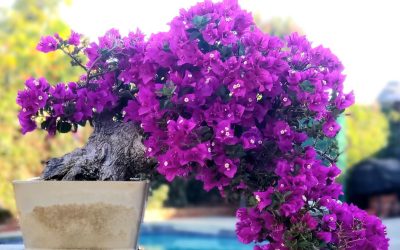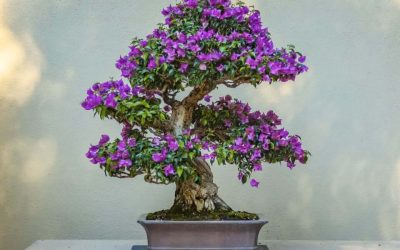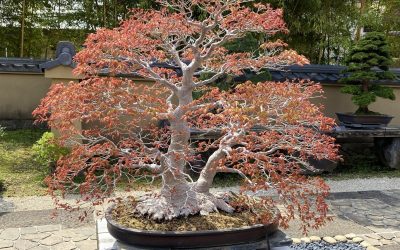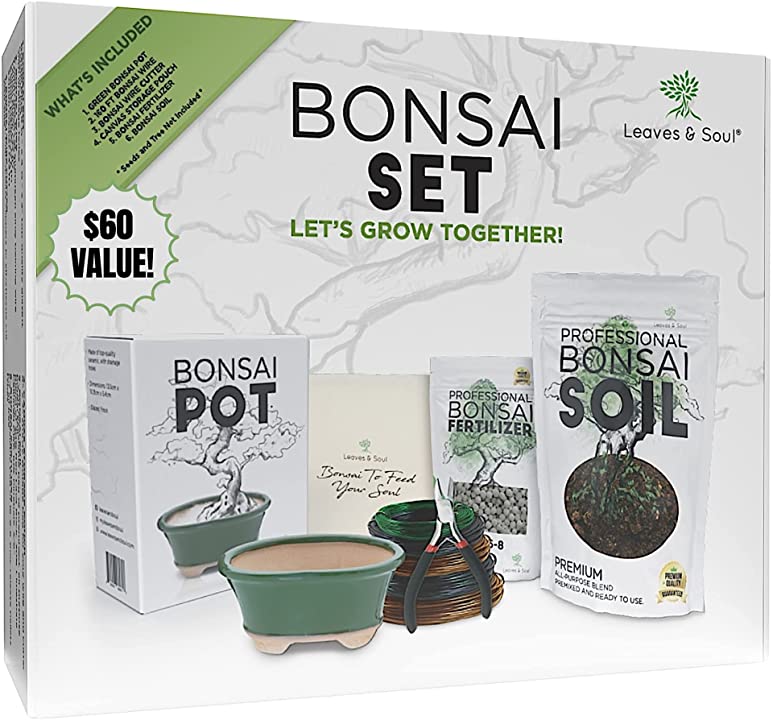Bonsai, an art form that originated in ancient China and was later redefined by Japan, is more than just horticulture.
This practice involves cultivating small trees to mimic the shape and style of their full-sized counterparts, encapsulating the essence of nature in a tiny, manageable form.
The word ‘bonsai’ translates to “planted in a container,” highlighting the core of this craft. It’s not about creating a genetically dwarfed plant but maintaining a mature tree in a miniaturized state.
Caring for a bonsai tree offers numerous benefits beyond aesthetics. It encourages patience, focus, and mindfulness.
Learning how to properly care for a bonsai tree shapes not just the tree but also our connection with nature and comprehension of life’s impermanence.
In this post, we’ll explore:
- Basic bonsai tree needs (watering, soil types, and sunlight requirements)
- Bonsai care techniques (bonsai tree pruning, wiring, repotting, and fertilizing)
- Common bonsai tree issues and solutions (pest and disease recognition, watering issues, and styling solutions)
Basic Bonsai Tree Needs
In understanding how to care for a bonsai tree, it’s essential to recognize their basic needs—water, soil, and sunlight. Let’s unravel how these elements play a crucial role in the life of your miniature trees.

Watering
Understand Your Tree’s Water Needs
Knowing your bonsai’s water needs is crucial. Different types of bonsais require varying amounts of water, influenced by factors like tree species, size, and location.
Research your specific tree’s needs. Generally, watering is needed when the top soil layer is dry.
Use the Right Watering Technique
Watering techniques vary – pouring water over soil until it drains or submerging the pot until soil is saturated are common methods. Avoid overwatering, as it is potentially damaging.
Consider the Environmental Factors
Environmental factors like temperature and humidity affect your bonsai’s water needs. More water may be necessary during hot, dry weather or if placed near heat sources. Adjust your watering schedule to keep your bonsai healthy.
Soil
One of the most critical components of bonsai care is the soil the tree is planted in. The soil is more than just a holder for your bonsai tree; it’s the primary source of nutrients and a reservoir for water and air.
Why is bonsai soil different from regular soil?
The soil of bonsai trees differs from regular soil due to its specific texture for adequate drainage and air movement, which is crucial for root health. It also needs a unique nutrient blend that avoids over-fertilization. The pot’s size and shape also impact your bonsai’s growth.
What makes up the right soil for bonsai plant health?
The ideal bonsai soil comprises three main components: akadama, pumice, and lava rock. Akadama, a type of volcanic clay, is the primary component with excellent water retention and promotes beneficial microorganisms. Pumice, light and porous, effectively retains water. Lava rock creates necessary air pockets in the soil for roots.
Sunlight
Sunlight is the life force for your bonsai tree, providing the energy it needs for photosynthesis. Most bonsai trees thrive with at least five hours of sunlight per day.
However, requirements can change based on the bonsai species and whether it’s placed indoors or outdoors.
Keeping Your Bonsai Tree Inside the Home
To ensure proper sunlight exposure, indoor bonsai trees require attentive care. Bonsai tree indoors thrive best in areas with at least four hours of direct sunlight daily, such as south-facing windows, sunrooms, or conservatories.
LED grow lights can serve as supplementary light sources when natural light is insufficient. Avoid placing indoor bonsai trees in drafty or extreme temperature areas to prevent damage.
Keeping Your Bonsai Tree Outdoors
Bonsai trees do well in outdoor conditions, benefiting from natural sunlight. Most outdoor bonsai trees need 5-6 hours of direct sunlight daily, ideally in the early morning or late afternoon.
Protect them from excessive sunlight by using shade cloths, screen wire, or window screens that provide up to 50% shade.
Bonsai Tree Care Techniques
Now that we’ve explored the basic needs of a bonsai tree, let’s delve deeper into the artistry and practical techniques that help these miniature marvels thrive.
This section will guide you through pruning, wiring, repotting, and fertilizing—each a crucial step in nurturing your bonsai to its full potential. Let’s continue our journey into this fascinating realm.

Pruning
When it comes to the care for a bonsai tree, pruning is an essential aspect that requires precision and understanding. You’ll need some handy tools – scissors for snipping small branches and leaves, concave cutters for the bigger branches, wire cutters for shaping those branches, and pliers for attaching guy wires and securing wires during repotting. These tools are your go-to for accurate and careful pruning.
In bonsai tree care, timing matters when it comes to pruning. You can do maintenance pruning anytime during the year, but for structural pruning, aim for once a year, either in early spring or late fall, when your tree is gearing up for a new growth cycle and is healthy.
But don’t forget, pruning a tree that’s stressed or sick might end up causing more harm than good. Keeping a watchful eye on your tree’s growth pattern will help you pick the right pruning time.
Pruning a bonsai tree isn’t a one-size-fits-all process. The clip-and-grow method is all about trimming back branches to coax out new sprouts and create a lush canopy.
And for those looking to get creative, carving is where you cut away sections of the trunk or branches to create a unique shape or design.
Wiring
Bonsai wiring, a crucial element of bonsai cultivation, involves wrapping wire around the tree’s parts to shape it. This centuries-old practice lets you create unique bonsai sculptures.
The process starts with selecting the right wire, usually pliable copper, about 1/3 the diameter of the branch/trunk to be wrapped. Then, decide the branch’s angle and direction, ensuring it aligns with its natural growth pattern to prevent damage.
Wrap the selected wire around the branch at a 45-degree angle for a natural curve. The wire should be snug but not damaging to the bark. Leave a 1/3 inch gap between each wire wrap for the branch’s growth.
Wires should remain for a few months, long enough to shape the tree but not damage it. Monitor the growth and remove the wire once the desired shape is achieved.
Successful bonsai wiring requires patience. As you master the technique and understand your tree, you’ll envision and create beautiful bonsai designs.
Repotting
The roots of bonsai trees get compacted over time, and the soil mix can become depleted of nutrients. Bonsai repotting provides an opportunity to examine the roots, cut away any unhealthy roots, and prune them to fit the new pot size.
The most fitting period to repot bonsai trees aligns with the onset of spring, just as your tree awakens from its winter rest. This timing is spot-on because the tree is about to enter a phase of new growth, which will help it bounce back from the repotting process.
When it comes to soil, bonsai requires a unique blend that gives the right moisture retention while allowing for good drainage. Choose a bonsai soil mixture that suits your bonsai tree species and pot-style requirements.

The first step in repotting is to remove any wires or stakes before unpotting your bonsai. Use a sharp bonsai pruning shear to trim away about one-third of the root mass.
Be sure to remove any unhealthy roots that are brown or black and trim any roots circling around the root mass or the pot. Then place the bonsai in the new pot with fresh soil mix, tamp it down, and water your bonsai thoroughly.
After repotting, keep your bonsai out of direct sunlight for a few weeks and mist it regularly to help it acclimate to its new pot. Remember to water it according to its needs and avoid overwatering.
Fertilizing
An integral part of care for a bonsai tree is ensuring it receives the right nutrients. Fertilizer, crucial for bonsai health, contains three key elements: Nitrogen for leaf and stem growth, Phosphorus for roots, fruits, and flowers, and Potassium for overall strength. Yet, choosing the right one can be daunting.
For evergreen conifers like Junipers, organic cakes or pellets can be used year-round, while deciduous trees like maples require fertilization from late spring to late autumn. The frequency and quantity of fertilizer depend on the season and pot size.
Avoid over-fertilizing by adhering to package guidelines. It’s better to be cautious, as overdoing it can harm your trees.
Seamlessly fitting into this regimen is Leaves & Soul’s 18-6-8 slow-release bonsai fertilizer pellet. Perfect for the growing season, it delivers essential nutrients for a robust bonsai. Just the right touch to ensure your bonsai’s healthy growth and resilience.
Common Bonsai Tree Issues and Solutions
As we continue our exploration of the captivating world of bonsai cultivation, it’s essential to arm ourselves with an understanding of potential obstacles. This section will provide you with the insight to identify prevalent concerns like pests, diseases, watering inconsistencies, and styling challenges.
With a watchful eye and a caring hand, you can navigate these hurdles and ensure your bonsai continues to grow and flourish. Let’s uncover the solutions to these common bonsai dilemmas.
Recognizing Pests and Diseases
Bonsais, like all living beings, are not immune to the occasional pest or disease. Stay vigilant for early warning signs such as leaf discoloration, peculiar spots, or slowed growth. Swift identification of these issues can be a game-changer, whether you’re dealing with a swarm of aphids, a fungal outbreak, or an episode of root rot. With your careful attention, your bonsai can bounce back stronger and more resilient.
Addressing Over- or Under-Watering
Hydrating your bonsai is an artful dance of precision. Too much water can trigger root decay, while too little can leave your tree parched and wilting. The secret lies in tuning into your bonsai’s unique needs, gauging the moisture level of the soil, and fine-tuning your watering schedule. It’s all about striking a perfect balance between dampness and aeration in the root system. Your bonsai relies on this harmony for its vitality and growth.
Solving Styling and Shaping Issues
Bonsai styling is an art form, and just like any art, there can be challenges. Perhaps your bonsai isn’t taking to the wire shaping, or maybe a branch isn’t growing as you’d anticipated. Don’t despair! Patience, gentle adjustments, and a touch of creativity can help you navigate these issues, turning perceived flaws into unique features of your living sculpture.
Conclusion: Cultivate Your Bonsai Expertise

Your growing skills in the art and care for a bonsai tree are not just enhancing your own journey. They can also help others on their own paths. The real magic of bonsai isn’t only in the tree but in the careful attention to detail and the persistence that’s put into looking after it.
Keep up with all things bonsai by regularly checking out our blog. It’s packed with useful tips and detailed info. It has everything you need to ensure your bonsai keeps thriving and bringing happiness.






0 Comments